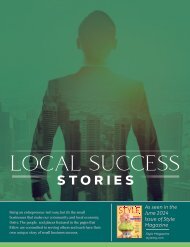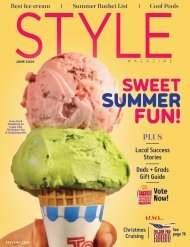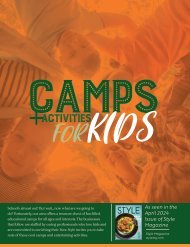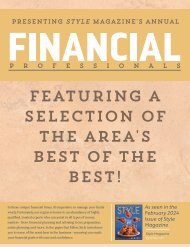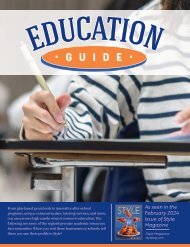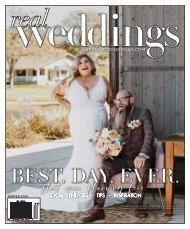Harris Center: Spring 2019
In addition to program notes for today’s show, inside this program guide you’ll find information about the many arts education programs offered by Folsom Lake College (page 7) as well as the college’s Innovation Center makerspace (page 12). There’s also a spotlight on some dance academies, one of the many local arts organizations that perform in the Center (page 14). Visit page 11 to learn about Center Gift Cards, Discount Ticket programs, Group Sales and the Center’s Perks Card program. To help you plan ahead, a listing of this season’s events is available on pages 60 and 61. Also within are acknowledgements of some of the cast that help make this all possible, including our members anddonors (pages 54-55) and sponsors (page 57) whose support of the Center is critical to its success, since ticket revenues alone simply do not cover all the costs of providing a world-class arts center. As you learn more about the Center and its programs, we hope you’ll also consider contributing to help us further expand the reach and impact of the Harris Center in this community. Again, thank you for attending today’s performance. We hope you’ll enjoy this great show, up close, and return for many more in the years ahead. Dave Pier Executive Director Harris Center for the Arts
In addition to program notes for today’s show, inside this program guide you’ll find information about the many arts education programs offered by Folsom Lake College (page 7) as well as the college’s Innovation Center makerspace (page 12). There’s also a spotlight on some dance academies, one of the many local arts organizations that perform in the Center (page 14). Visit page 11 to learn about Center Gift Cards, Discount Ticket programs, Group Sales and the Center’s Perks Card program. To help you plan ahead, a listing of this season’s events is available on pages 60 and 61. Also within are acknowledgements of some of the cast that help make this all possible, including our members anddonors (pages 54-55) and sponsors (page 57) whose support of the Center is critical to its success, since ticket revenues alone simply do not cover all the costs of providing a world-class arts center. As you learn more about the Center and its programs, we hope you’ll also consider contributing to help us further expand the reach and impact of the Harris Center in this community.
Again, thank you for attending today’s performance. We hope you’ll enjoy this great show, up close, and return for many more in the years ahead.
Dave Pier
Executive Director
Harris Center for the Arts
You also want an ePaper? Increase the reach of your titles
YUMPU automatically turns print PDFs into web optimized ePapers that Google loves.
MARK HUMMEL'S <strong>2019</strong> SOUTHERN HARP BLOWOUT<br />
continued<br />
know where to buy one, even if I had the money. I was a country<br />
boy,” he says. After seeing a picture of a guitar in a magazine,<br />
he decided to make one by attaching the top wire of a broom to<br />
a wall and fretting it with a bottle. He also got some harmonica<br />
lessons from his father. He eventually acquired a real guitar,<br />
and started playing in juke joints as a teenager, when his family<br />
briefly relocated to Little Rock, Arkansas. The fake moustache<br />
Rush wore made club owners believe he was old enough to<br />
gain entry into their establishments. While he was living in<br />
Little Rock, Rush’s band, which featured Elmore James, had a<br />
residency at a nightspot called Jackrabbit.<br />
During the mid-1950s, Rush relocated to Chicago to pursue<br />
his musical career and make a better life for himself. It was<br />
there that he started to work with Earl Hooker, Luther Allison,<br />
and Freddie King sat in with many of his musical heroes, such<br />
as Howlin’ Wolf, Muddy Waters, Jimmy Reed, Willie Dixon, and<br />
Little Walter. Rush eventually began leading his own band in the<br />
1960s. He also started to craft his own distinct style of funky<br />
blues, and recorded a succession of singles for a various small<br />
labels. It wasn’t until the early 1970’s that Rush finally scored a<br />
hit with “Chicken Heads.” More recordings followed, including<br />
an album for Kenny Gamble and Leon Huff’s Philadelphia<br />
International Label.<br />
Rush relocated one final time to Jackson, Mississippi in the<br />
early 1980s. He was tired of the cold up north, and he realized<br />
that setting up his base of operations directly in the center of<br />
the South would make it easier to perform in nearby cities<br />
on weekends. More indie label recordings followed. Songs<br />
like “Sue, A Man Can Give (But He Sure Can’t Take It),” “What’s<br />
Good For The Goose Is Good For The Gander Too,” and” I Ain’t<br />
Studdin’ You” became regional jukebox favorites in juke joints<br />
throughout the region, and many of those songs are still fan<br />
favorites that are an integral part of his live repertoire. Make<br />
no mistake, Bobby Rush is both a Bluesman and an entertainer<br />
of the highest order!<br />
KENNY NEAL<br />
If you want to experience the "Real Deal,"<br />
take time out to find Kenny Neal. One<br />
of the strongest modern proponents<br />
of Baton Rouge swamp blues, Kenny<br />
Neal is a second-generation southern<br />
Louisiana bluesman who is cognizant<br />
of the region's venerable blues tradition<br />
and imaginative enough to steer it in<br />
fresh directions. Neal was born on<br />
October 14, 1957 in New Orleans. His dad, harpist Raful Neal,<br />
was a Baton Rouge blues mainstay whose pals included Buddy<br />
Guy and Slim Harpo (the latter gave three-year-old Kenny his<br />
first harmonica).<br />
At age 13, Neal was playing in his father's band, and at 17,<br />
landed a job playing bass for Buddy Guy. The guitarist recruited<br />
some of his talented siblings to form the Neal Brothers Blues<br />
Band up in Toronto (brother Noel later played bass behind<br />
James Cotton; five other Neal brothers also play in various<br />
bands) before returning stateside. In 1987, Kenny Neal cut<br />
his debut LP for Florida producer Bob Greenlee, an updated<br />
swamp feast initially released by Kingsnake Records as Bio<br />
on the Bayou. The following year, Alligator Records signed<br />
Neal and reissued the debut under the title Big News from<br />
Baton Rouge!! Young Neal was on his way. Neal's sizzling guitar<br />
work, sturdy harp, and gravelly, aged-beyond-his-years vocals<br />
served him well, and he cut four albums for Alligator Records<br />
between 1989 and 1994. An acclaimed 1991 stint on Broadway<br />
in a production of Mule Bone found him performing acoustic<br />
versions of Langston Hughes' poetry set to music by Taj Mahal.<br />
In 1998, Neal moved from Alligator to the blues division of<br />
the jazz-based Telarc Records, releasing three albums for<br />
the label: Blues Fallin' Down Like Rain (1998), What You Got<br />
(2000), and One Step Closer (2001). In the new millennium, Neal<br />
recorded sets for a variety of independent labels, including Easy<br />
Meeting (a 2003 collaboration with Billy Branch), Double Take<br />
(2004, a one-shot return to Alligator), and A Tribute to Slim Harpo<br />
and Raful Neal (released in 2005 for True Life Entertainment).<br />
Three years later, Neal hooked up with Blind Pig Records and<br />
released Let Life Flow in 2008, once again incorporating his<br />
gritty Louisiana roots with a sophisticated Chicago/Memphis<br />
soul approach. A second Blind Pig release, Hooked on Your Love,<br />
appeared two years later in 2010.<br />
In 2015, Neal released his first holiday-themed album, I'll<br />
Be Home for Christmas. It was his first album for Cleopatra<br />
Records, which also issued his critically acclaimed release,<br />
Bloodline in 2016.<br />
Kenny's 2016 release, Bloodline, was nomimated for a 2017<br />
Grammy for Best Contemporary Blues Album and also won two<br />
2017 BMAs (Blues Music Awards); one for Best Contemporary<br />
Blues Album and the other for Best Contemporary Male Blues<br />
Artist. Kenny Neal, a true living blues Legend is THE REAL<br />
DEAL and more poised than ever to deliver the blues like no<br />
one else can!<br />
JAMES HARMAN<br />
James was born and raised in Anniston,<br />
Alabama-quickly picked up on the black<br />
blues and soul music being played on<br />
juke boxes and the radio. He sang in<br />
the church choir until age 16 when his<br />
family moved to Panama City, Florida,<br />
where he found himself surrounded<br />
by like-minded blues lovers. Wearing a<br />
fake moustache, young James slipped<br />
into a still segregated black nightclub to see Little Junior<br />
Parker’s show. He was totally overtaken by the blues and soon<br />
became a regular, known as “That boy who sings like a man”<br />
by patrons.<br />
While still in his teens, he started playing juke joints and<br />
dance clubs throughout the South. His performances became<br />
legendary-he was “tapped” by talent scouts, signed and taken<br />
to Atlanta, Georgia in 1964 to begin his recording career at age<br />
18. He had a series of nine singles (45 RPM records) released<br />
during the mid to late 60's on obscure southern labels. He tried<br />
several restarts in new home bases including Chicago in ’65,<br />
New York in ’66, Miami in ’68 and New Orleans in ‘69.<br />
During his stay in Miami Harman was befriended by fellow<br />
record collectors Henry Vestine, Alan Wilson and Bob Hite<br />
of Canned Heat, who persuaded him to move to California,<br />
18 2018-<strong>2019</strong> SEASON PROGRAM GUIDE www.harriscenter.net



